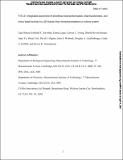| dc.contributor.author | Large, Emma | |
| dc.contributor.author | Hughes, David J. | |
| dc.contributor.author | Sarkar, Ujjal | |
| dc.contributor.author | Ravindra, Kodihalli C. | |
| dc.contributor.author | Young, Carissa L. | |
| dc.contributor.author | Rivera-Burgos, Dinelia | |
| dc.contributor.author | Yu, Jiajie | |
| dc.contributor.author | Cirit, Murat | |
| dc.contributor.author | Wishnok, John S | |
| dc.contributor.author | Lauffenburger, Douglas A | |
| dc.contributor.author | Griffith, Linda G | |
| dc.contributor.author | Tannenbaum, Steven R | |
| dc.date.accessioned | 2017-08-18T15:46:07Z | |
| dc.date.available | 2017-08-18T15:46:07Z | |
| dc.date.issued | 2017-06 | |
| dc.date.submitted | 2016-11 | |
| dc.identifier.issn | 0090-9556 | |
| dc.identifier.issn | 1521-009X | |
| dc.identifier.uri | http://hdl.handle.net/1721.1/110981 | |
| dc.description.abstract | In vitro hepatocyte culture systems have inherent limitations in capturing known human drug toxicities that arise from complex immune responses. Therefore, we established and characterized a liver immunocompetent coculture model and evaluated diclofenac (DCF) metabolic profiles, in vitro–in vivo clearance correlations, toxicological responses, and acute phase responses using liquid chromatography–tandem mass spectrometry. DCF biotransformation was assessed after 48 hours of culture, and the major phase I and II metabolites were similar to the in vivo DCF metabolism profile in humans. Further characterization of secreted bile acids in the medium revealed that a glycine-conjugated bile acid was a sensitive marker of dose-dependent toxicity in this three-dimensional liver microphysiological system. Protein markers were significantly elevated in the culture medium at high micromolar doses of DCF, which were also observed previously for acute drug-induced toxicity in humans. In this immunocompetent model, lipopolysaccharide treatment evoked an inflammatory response that resulted in a marked increase in the overall number of acute phase proteins. Kupffer cell–mediated cytokine release recapitulated an in vivo proinflammatory response exemplified by a cohort of 11 cytokines that were differentially regulated after lipopolysaccharide induction, including interleukin (IL)-1β, IL-1Ra, IL-6, IL-8, IP-10, tumor necrosis factor-α, RANTES (regulated on activation normal T cell expressed and secreted), granulocyte colony-stimulating factor, macrophage colony-stimulating factor, macrophage inflammatory protein-1β, and IL-5. In summary, our findings indicate that three-dimensional liver microphysiological systems may serve as preclinical investigational platforms from the perspective of the discovery of a set of clinically relevant biomarkers including potential reactive metabolites, endogenous bile acids, excreted proteins, and cytokines to predict early drug-induced liver toxicity in humans. | en_US |
| dc.language.iso | en_US | |
| dc.publisher | American Society for Pharmacology & Experimental Therapeutics (ASPET) | en_US |
| dc.relation.isversionof | http://dx.doi.org/10.1124/dmd.116.074005 | en_US |
| dc.rights | Creative Commons Attribution-Noncommercial-Share Alike | en_US |
| dc.rights.uri | http://creativecommons.org/licenses/by-nc-sa/4.0/ | en_US |
| dc.source | Prof. Griffith via Howard Silver | en_US |
| dc.title | Integrated Assessment of Diclofenac Biotransformation, Pharmacokinetics, and Omics-Based Toxicity in a Three-Dimensional Human Liver-Immunocompetent Coculture System | en_US |
| dc.type | Article | en_US |
| dc.identifier.citation | Sarkar, Ujjal et al. “Integrated Assessment of Diclofenac Biotransformation, Pharmacokinetics, and Omics-Based Toxicity in a Three-Dimensional Human Liver-Immunocompetent Coculture System.” Drug Metabolism and Disposition 45, 7 (April 2017): 855–866 © 2017 The Author(s) | en_US |
| dc.contributor.department | Massachusetts Institute of Technology. Department of Biological Engineering | en_US |
| dc.contributor.department | Massachusetts Institute of Technology. Department of Chemistry | en_US |
| dc.contributor.approver | Griffith, Linda | en_US |
| dc.contributor.mitauthor | Sarkar, Ujjal | |
| dc.contributor.mitauthor | Ravindra, Kodihalli C. | |
| dc.contributor.mitauthor | Young, Carissa L. | |
| dc.contributor.mitauthor | Rivera-Burgos, Dinelia | |
| dc.contributor.mitauthor | Yu, Jiajie | |
| dc.contributor.mitauthor | Cirit, Murat | |
| dc.contributor.mitauthor | Wishnok, John S | |
| dc.contributor.mitauthor | Lauffenburger, Douglas A | |
| dc.contributor.mitauthor | Griffith, Linda G | |
| dc.contributor.mitauthor | Tannenbaum, Steven R | |
| dc.relation.journal | Drug Metabolism and Disposition | en_US |
| dc.eprint.version | Author's final manuscript | en_US |
| dc.type.uri | http://purl.org/eprint/type/JournalArticle | en_US |
| eprint.status | http://purl.org/eprint/status/PeerReviewed | en_US |
| dspace.orderedauthors | Sarkar, Ujjal; Ravindra, Kodihalli C.; Large, Emma; Young, Carissa L.; Rivera-Burgos, Dinelia; Yu, Jiajie; Cirit, Murat; Hughes, David J.; Wishnok, John S.; Lauffenburger, Douglas A.; Griffith, Linda G.; Tannenbaum, Steven R. | en_US |
| dspace.embargo.terms | N | en_US |
| dc.identifier.orcid | https://orcid.org/0000-0002-8581-1261 | |
| dc.identifier.orcid | https://orcid.org/0000-0002-9618-8495 | |
| dc.identifier.orcid | https://orcid.org/0000-0001-6975-5047 | |
| dc.identifier.orcid | https://orcid.org/0000-0002-2325-552X | |
| dc.identifier.orcid | https://orcid.org/0000-0002-1801-5548 | |
| mit.license | OPEN_ACCESS_POLICY | en_US |
| mit.metadata.status | Complete | |
